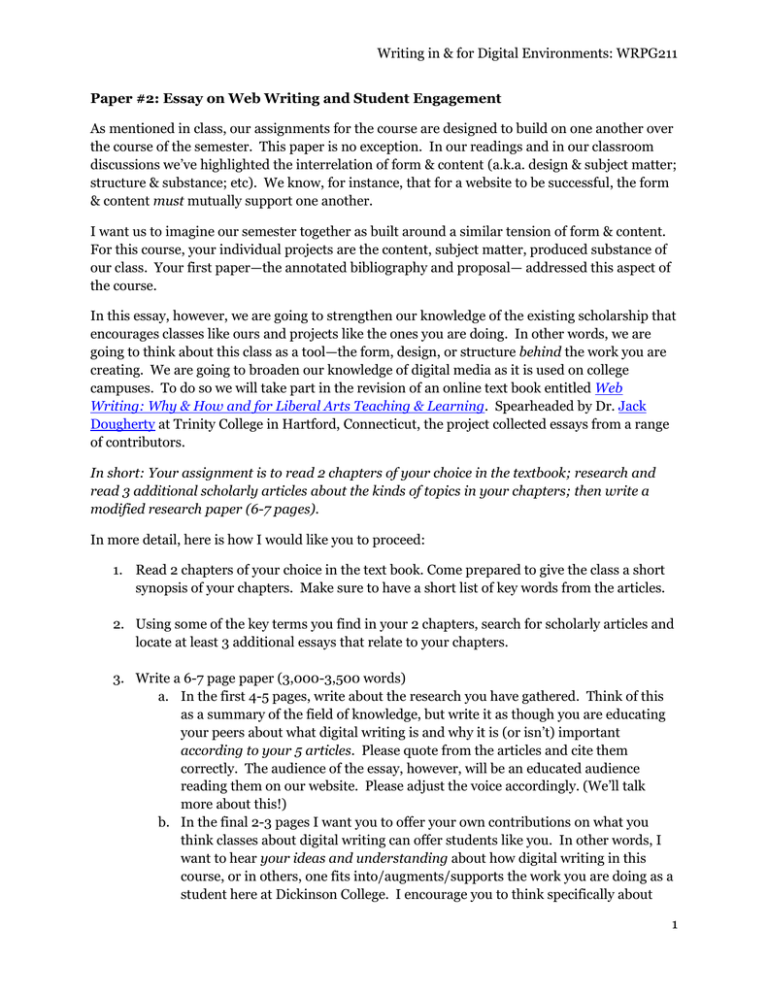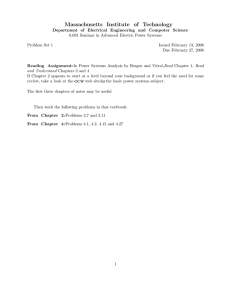Paper #2 Prompt
advertisement

Writing in & for Digital Environments: WRPG211 Paper #2: Essay on Web Writing and Student Engagement As mentioned in class, our assignments for the course are designed to build on one another over the course of the semester. This paper is no exception. In our readings and in our classroom discussions we’ve highlighted the interrelation of form & content (a.k.a. design & subject matter; structure & substance; etc). We know, for instance, that for a website to be successful, the form & content must mutually support one another. I want us to imagine our semester together as built around a similar tension of form & content. For this course, your individual projects are the content, subject matter, produced substance of our class. Your first paper—the annotated bibliography and proposal— addressed this aspect of the course. In this essay, however, we are going to strengthen our knowledge of the existing scholarship that encourages classes like ours and projects like the ones you are doing. In other words, we are going to think about this class as a tool—the form, design, or structure behind the work you are creating. We are going to broaden our knowledge of digital media as it is used on college campuses. To do so we will take part in the revision of an online text book entitled Web Writing: Why & How and for Liberal Arts Teaching & Learning. Spearheaded by Dr. Jack Dougherty at Trinity College in Hartford, Connecticut, the project collected essays from a range of contributors. In short: Your assignment is to read 2 chapters of your choice in the textbook; research and read 3 additional scholarly articles about the kinds of topics in your chapters; then write a modified research paper (6-7 pages). In more detail, here is how I would like you to proceed: 1. Read 2 chapters of your choice in the text book. Come prepared to give the class a short synopsis of your chapters. Make sure to have a short list of key words from the articles. 2. Using some of the key terms you find in your 2 chapters, search for scholarly articles and locate at least 3 additional essays that relate to your chapters. 3. Write a 6-7 page paper (3,000-3,500 words) a. In the first 4-5 pages, write about the research you have gathered. Think of this as a summary of the field of knowledge, but write it as though you are educating your peers about what digital writing is and why it is (or isn’t) important according to your 5 articles. Please quote from the articles and cite them correctly. The audience of the essay, however, will be an educated audience reading them on our website. Please adjust the voice accordingly. (We’ll talk more about this!) b. In the final 2-3 pages I want you to offer your own contributions on what you think classes about digital writing can offer students like you. In other words, I want to hear your ideas and understanding about how digital writing in this course, or in others, one fits into/augments/supports the work you are doing as a student here at Dickinson College. I encourage you to think specifically about 1 Writing in & for Digital Environments: WRPG211 your semester project, your particular major, experiences you have had in other courses/internships/co-curricular activities, and, finally, your goals beyond Dickinson. Our text book focuses on Liberal Arts education and civic engagement and you are welcome to think about these ideas as well. 4. We will Peer Review this paper in class. 5. Finally, using the knowledge you have acquired, you will go back to the online textbook and offer 4 comments across your two chapters as a way to engage with the revision process of this online text book. These comments will count as part of your grade for the final draft of the paper. Due Date List (also posted on our class blog): Thurs 9/26 Pick two more articles (your choice!) from the table of contents and read them Bring in a short summary of the article’s main points and ideas. Please pay attention to, and list out any key terms. I reserve the right to collect these. Read through the section "About the Open Peer Review" for Web Writing: Why & How and for Liberal Arts Teaching & Learning Thurs 10/3 Rough Draft of Paper #2 due in class (please bring 2 copies). We will do peer review in class. Sunday 10/13 Final draft due including the text from your 4 comments on the textbook. (See grading rubric) Post your 4 comments to the online textbook 2 Writing in & for Digital Environments: WRPG211 “Does it make effective use of web-essay format by integrating narrative text with appropriate digital elements (such as links, photos, charts, maps, videos)?” Whether on paper or on the web, good writing must stand on its own two feet. - See more at: http://webwriting.trincoll.edu/goodweb-essay/#sthash.iIa5weDa.dpuf Rather than typing a traditional final paper to be read only by their professor, students in the Cities Suburbs and Schools seminar compose web-essays, which blend textual narrative and digital evidence for a public audience that includes invited guest evaluators. All readers are encouraged to comment, especially in response to our criteria: 1. Does the web-essay present a compelling argument or story about a significant aspect of the course? Does it inspire the reader to think in new ways? 2. Are the claims supported with appropriate evidence and is the reasoning well developed? Is counter-evidence fully considered? 3. Does it make effective use of web-essay format by integrating narrative text with appropriate digital elements (such as links, photos, charts, maps, videos)? 4. Is the web-essay organized and well written? 5. Does it include sufficient background for audiences unfamiliar with the topic? 6. Does it cite all sources in an appropriate format that future readers may find? - See more at: http://webwriting.trincoll.edu/good-web-essay/#sthash.iIa5weDa.dpuf 3



